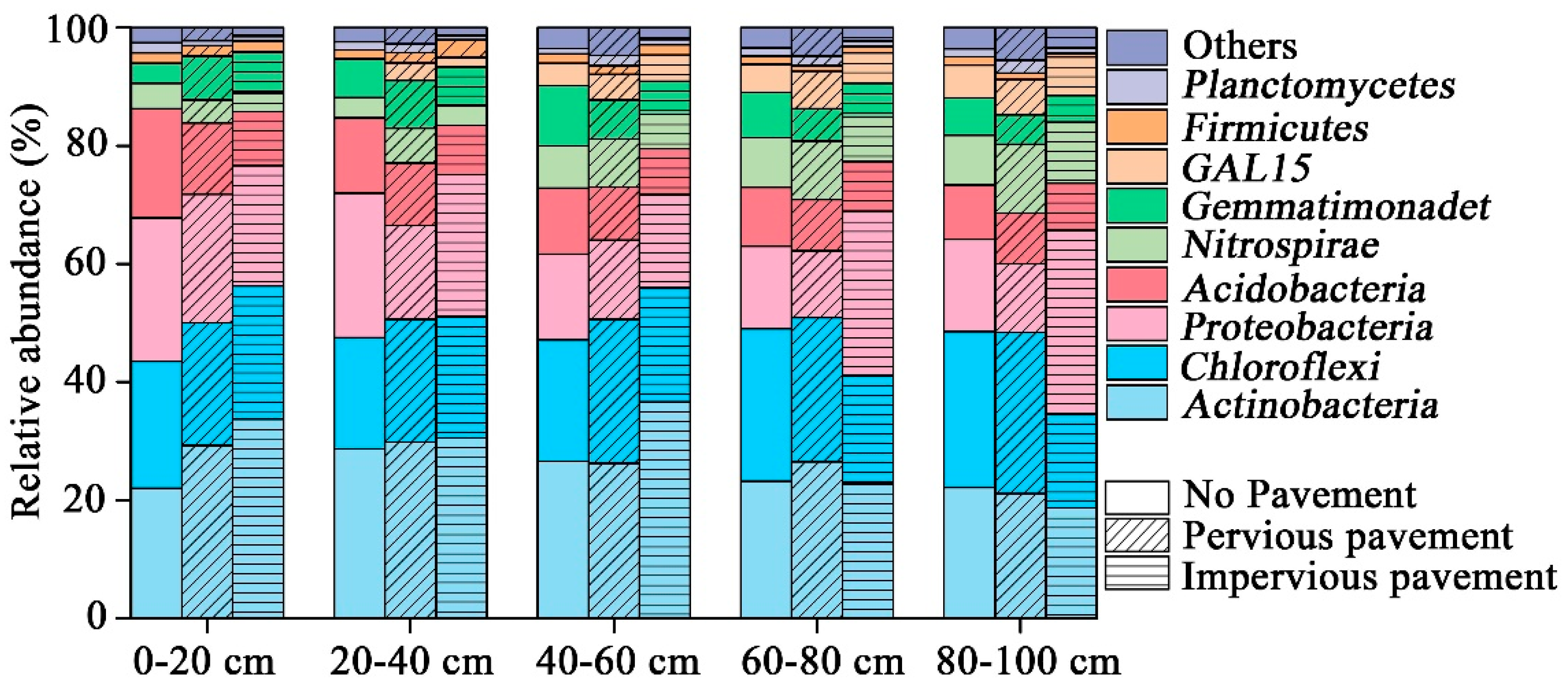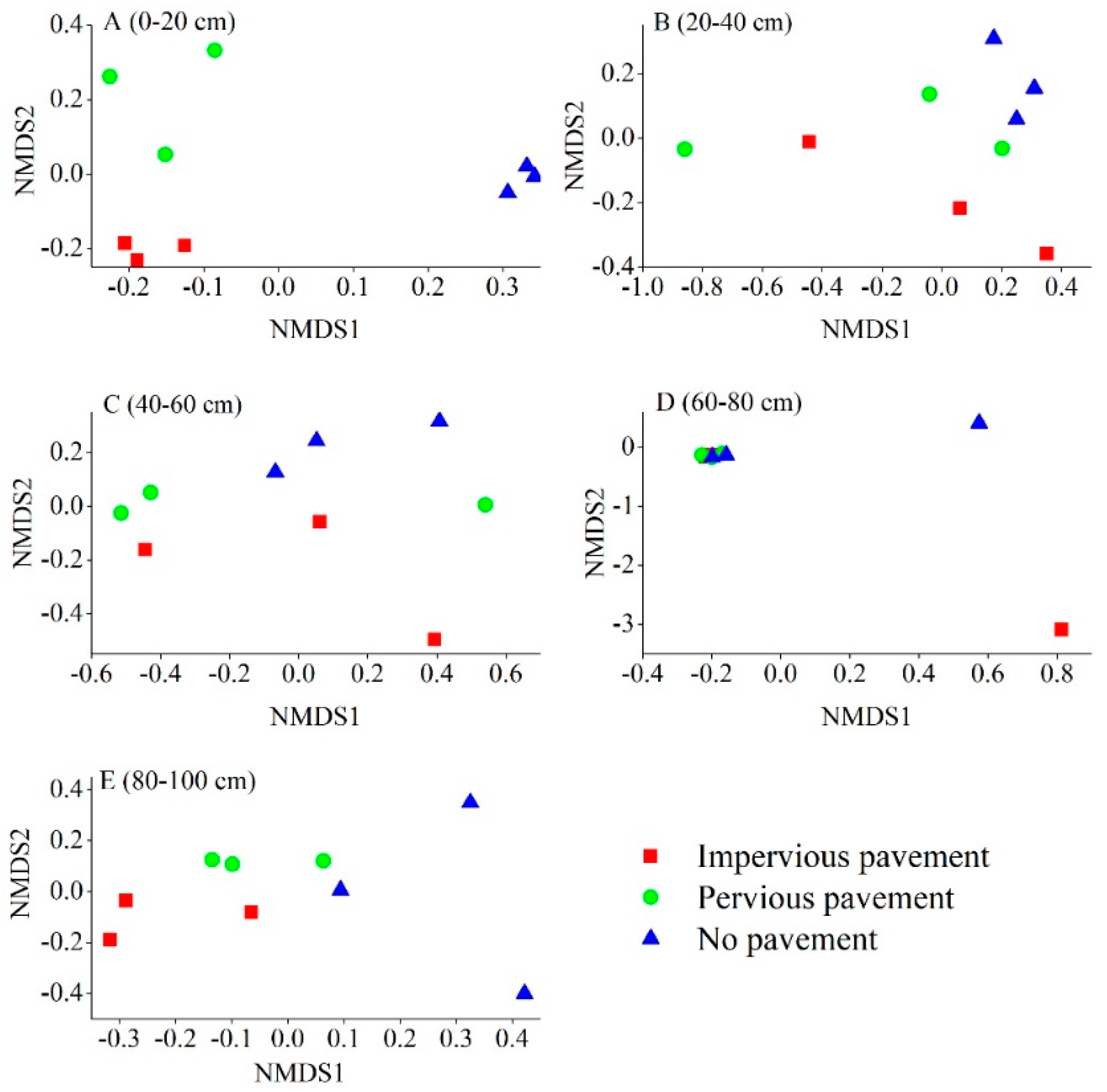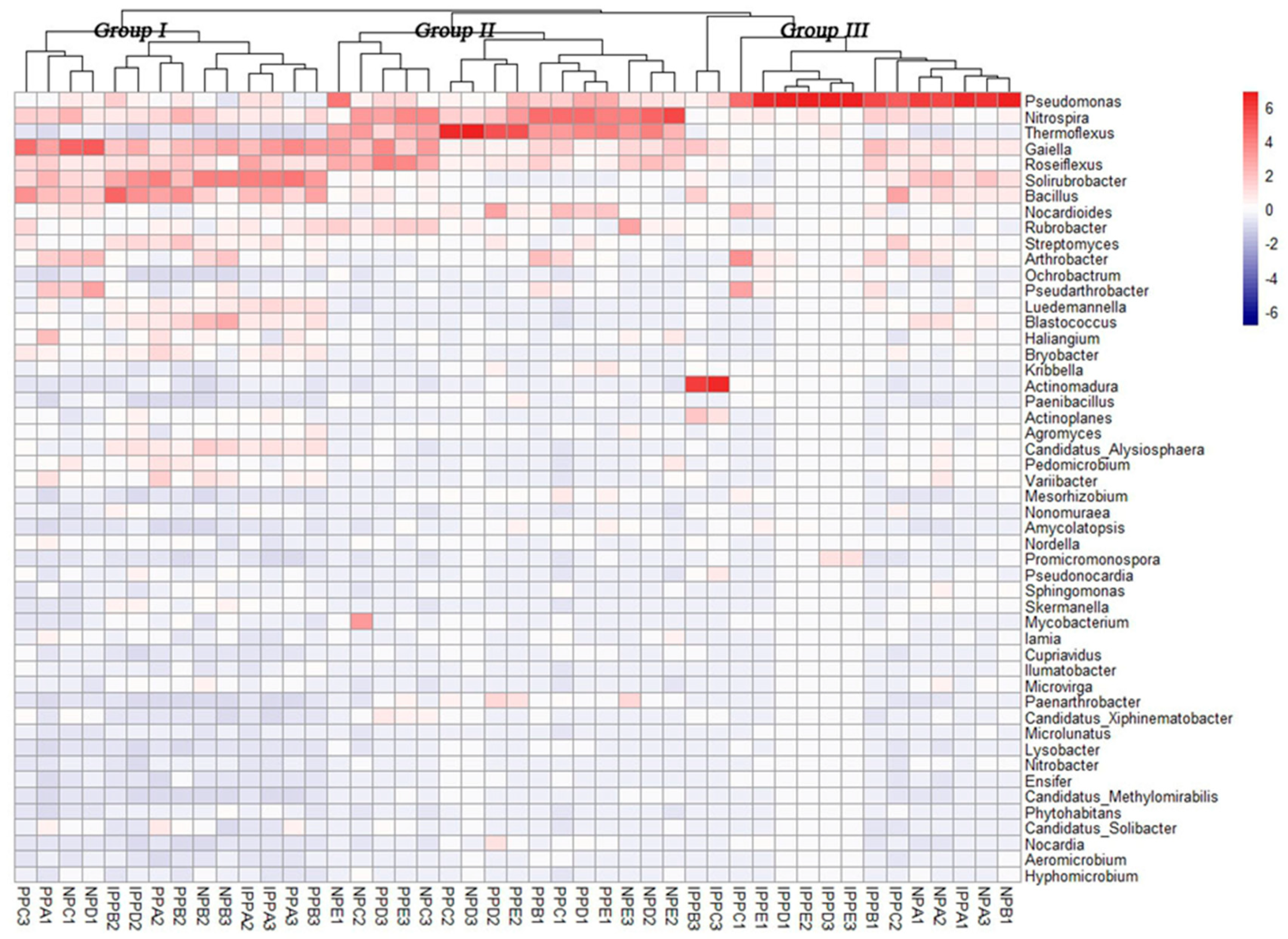The Effects of Pavement Types on Soil Bacterial Communities across Different Depths
Abstract
1. Introduction
2. Materials and Methods
2.1. Experimental Site Description and Design
2.2. Soil Sampling
2.3. Determination of Soil Properties
2.4. DNA Extraction and High-Throughput Sequencing
2.5. Sequence Analysis
2.6. Data Analysis
3. Results
3.1. Bacterial Community Composition
3.2. Effects of Land Pavement on Soil Bacterial Alpha Diversity
3.3. Variables Correlated with Bacterial Abundance and Composition
4. Discussion
5. Conclusions
Supplementary Materials
Author Contributions
Funding
Acknowledgments
Conflicts of Interest
References
- Elvidge, C.D.; Tuttle, B.T.; Sutton, P.C.; Baugh, K.E.; Howard, A.T.; Milesi, C.; Bhaduri, B.; Nemani, R. Global Distribution and Density of Constructed Impervious Surfaces. Sensors 2007, 7, 1962–1979. [Google Scholar] [CrossRef]
- Scalenghe, R.; Marsan, F.A. The anthropogenic sealing of soils in urban areas. Landsc. Urban Plan. 2009, 90, 1–10. [Google Scholar] [CrossRef]
- Raciti, S.M.; Hutyra, L.R.; Finzi, A.C. Depleted soil carbon and nitrogen pools beneath impervious surfaces. Environ. Pollut. 2012, 164, 248–251. [Google Scholar] [CrossRef]
- Hu, Y.; Dou, X.; Li, J.; Li, F. Impervious Surfaces Alter Soil Bacterial Communities in Urban Areas: A Case Study in Beijing, China. Front. Microbiol. 2018, 9. [Google Scholar] [CrossRef]
- Zhao, D.; Li, F.; Wang, R. The effects of different urban land use patterns on soil microbial biomass nitrogen and enzyme activities in urban area of Beijing, China. Acta Ecol. Sin. 2012, 32, 144–149. [Google Scholar] [CrossRef]
- Wolińska, A.; Stępniewska, Z.; Pytlak, A. The effect of environmental factors on total soil DNA content and dehydrogenase activity. Arch. Biol. Sci. 2015, 67, 493–501. [Google Scholar] [CrossRef]
- Agnelli, A.; Ascher, J.; Corti, G.; Ceccherini, M.T.; Nannipieri, P.; Pietramellara, G. Distribution of microbial communities in a forest soil profile investigated by microbial biomass, soil respiration and DGGE of total and extracellular DNA. Soil Biol. Biochem. 2004, 36, 859–868. [Google Scholar] [CrossRef]
- Schlatter, D.C.; Bakker, M.G.; Bradeen, J.M.; Kinkel, L.L. Plant community richness and microbial interactions structure bacterial communities in soil. Ecology 2015, 96, 134–142. [Google Scholar] [CrossRef] [PubMed]
- Bardgett, R.D.; Freeman, C.; Ostle, N.J. Microbial contributions to climate change through carbon cycle feedbacks. ISME J. 2008, 2, 805. [Google Scholar] [CrossRef]
- Taylor, J.P.; Wilson, B.; Mills, M.S.; Burns, R.G. Comparison of microbial numbers and enzymatic activities in surface soils and subsoils using various techniques. Soil Biol. Biochem. 2002, 34, 387–401. [Google Scholar] [CrossRef]
- Will, C.; Thürmer, A.; Wollherr, A.; Nacke, H.; Herold, N.; Schrumpf, M.; Gutknecht, J.; Wubet, T.; Buscot, F.; Daniel, R. Horizon-Specific Bacterial Community Composition of German Grassland Soils, as Revealed by Pyrosequencing-Based Analysis of 16S rRNA Genes. Appl. Environ. Microbiol. 2010, 76, 6751–6759. [Google Scholar] [CrossRef]
- Van Leeuwen, J.P.; Djukic, I.; Bloem, J.; Lehtinen, T.; Hemerik, L.; de Ruiter, P.C.; Lair, G.J. Effects of land use on soil microbial biomass, activity and community structure at different soil depths in the Danube floodplain. Eur. J. Soil Biol. 2017, 79, 14–20. [Google Scholar] [CrossRef]
- Stone, M.M.; Kan, J.; Plante, A.F. Parent material and vegetation influence bacterial community structure and nitrogen functional genes along deep tropical soil profiles at the Luquillo Critical Zone Observatory. Soil Biol. Biochem. 2015, 80, 273–282. [Google Scholar] [CrossRef]
- Mullaney, J.; Lucke, T.; Trueman, S.J. A review of benefits and challenges in growing street trees in paved urban environments. Landsc. Urban Plan. 2015, 134, 157–166. [Google Scholar] [CrossRef]
- Szota, C.; Coutts, A.M.; Thom, J.K.; Virahsawmy, H.K.; Fletcher, T.D.; Livesley, S.J. Street tree stormwater control measures can reduce runoff but may not benefit established trees. Landsc. Urban Plan. 2019, 182, 144–155. [Google Scholar] [CrossRef]
- Blume, E.; Bischoff, M.; Reichert, J.M.; Moorman, T.; Konopka, A.; Turco, R.F. Surface and subsurface microbial biomass, community structure and metabolic activity as a function of soil depth and season. Appl. Soil Ecol. 2002, 20, 171–181. [Google Scholar] [CrossRef]
- Fierer, N.; Schimel, J.P.; Holden, P.A. Variations in microbial community composition through two soil depth profiles. Soil Biol. Biochem. 2003, 35, 167–176. [Google Scholar] [CrossRef]
- Van Der Heijden, M.G.A.; Bardgett, R.D.; Van Straalen, N.M. The unseen majority: soil microbes as drivers of plant diversity and productivity in terrestrial ecosystems. Ecology 2008, 11, 296–310. [Google Scholar] [CrossRef] [PubMed]
- Liu, W.; Chen, W.; Peng, C. Influences of setting sizes and combination of green infrastructures on community’s stormwater runoff reduction. Ecol. Modell. 2015, 318, 236–244. [Google Scholar] [CrossRef]
- Sansalone, J.; Kuang, X.; Ying, G.; Ranieri, V. Filtration and clogging of permeable pavement loaded by urban drainage. Water Res. 2012, 46, 6763–6774. [Google Scholar] [CrossRef] [PubMed]
- Piotrowska-Długosz, A.; Charzyński, P. The impact of the soil sealing degree on microbial biomass, enzymatic activity, and physicochemical properties in the Ekranic Technosols of Toruń (Poland). J. Soils Sediments 2015, 15, 47–59. [Google Scholar] [CrossRef]
- Viswanathan, B.; Volder, A.; Watson, W.T.; Aitkenhead-Peterson, J.A. Impervious and pervious pavements increase soil CO2 concentrations and reduce root production of American sweetgum (Liquidambar styraciflua). Urban For. Urban Green. 2011, 10, 133–139. [Google Scholar] [CrossRef]
- Bao, S.D. Soil Agricultural Chemical Elements Analysis; Agriculture Press: Beijing, China, 2000. [Google Scholar]
- Bray, R.H.; Kurtz, L.T.J.S.S. Determination of Total, Organic, and Available Forms of Phosphorus in Soils. Soil Sci. 1945, 59, 39–46. [Google Scholar] [CrossRef]
- Caporaso, J.G.; Kuczynski, J.; Stombaugh, J.; Bittinger, K.; Bushman, F.D.; Costello, E.K.; Fierer, N.; Peña, A.G.; Goodrich, J.K.; Gordon, J.I.; et al. QIIME allows analysis of high-throughput community sequencing data. Nat. Methods 2010, 7, 335. [Google Scholar] [CrossRef]
- Edgar, R.C. Search and clustering orders of magnitude faster than BLAST. Bioinformatics 2010, 26, 2460–2461. [Google Scholar] [CrossRef]
- Bokulich, N.A.; Subramanian, S.; Faith, J.J.; Gevers, D.; Gordon, J.I.; Knight, R.; Mills, D.A.; Caporaso, J.G. Quality-filtering vastly improves diversity estimates from Illumina amplicon sequencing. Nat. Methods 2012, 10, 57. [Google Scholar] [CrossRef]
- R Development Core Team. R: A Language and Environment for Statistical Computing; R Foundation for Statistical Computing: Vienna, Austria, 2013. [Google Scholar]
- Zhao, D.; Li, F.; Wang, R.; Yang, Q.; Ni, H.J.J.o.S. Effect of soil sealing on the microbial biomass, N transformation and related enzyme activities at various depths of soils in urban area of Beijing, China. J. Soils Sediments 2012, 12, 519–530. [Google Scholar] [CrossRef]
- Wei, Z.; Wu, S.; Zhou, S.; Lin, C. Installation of impervious surface in urban areas affects microbial biomass, activity (potential C mineralisation), and functional diversity of the fine earth. Soil Res. 2013, 51, 59–67. [Google Scholar] [CrossRef]
- Steinauer, K.; Chatzinotas, A.; Eisenhauer, N. Root exudate cocktails: the link between plant diversity and soil microorganisms? Ecol. Evol. 2016, 6, 7387–7396. [Google Scholar] [CrossRef]
- Miller, A.J.; Hirsch, P.R.; Dennis, P.G. Are root exudates more important than other sources of rhizodeposits in structuring rhizosphere bacterial communities? FEMS Microbiol. Ecol. 2010, 72, 313–327. [Google Scholar] [CrossRef]
- Koranda, M.; Schnecker, J.; Kaiser, C.; Fuchslueger, L.; Kitzler, B.; Stange, C.F.; Sessitsch, A.; Zechmeister-Boltenstern, S.; Richter, A. Microbial processes and community composition in the rhizosphere of European beech—The influence of plant C exudates. Soil Biol. Biochem. 2011, 43, 551–558. [Google Scholar] [CrossRef] [PubMed]
- Delgado-Baquerizo, M.; Maestre, F.T.; Reich, P.B.; Jeffries, T.C.; Gaitan, J.J.; Encinar, D.; Berdugo, M.; Campbell, C.D.; Singh, B.K. Microbial diversity drives multifunctionality in terrestrial ecosystems. Nat. Commun. 2016, 7, 10541. [Google Scholar] [CrossRef]
- Wolińska, A.; Kuźniar, A.; Zielenkiewicz, U.; Banach, A.; Izak, D.; Stępniewska, Z.; Błaszczyk, M. Metagenomic analysis of some potential nitrogen-fixing bacteria in arable soils at different formation process. Microb. Ecol. 2017, 73, 162–176. [Google Scholar] [CrossRef] [PubMed]
- Schweitzer, J.A.; Bailey, J.K.; Fischer, D.G.; LeRoy, C.J.; Lonsdorf, E.V.; Whitham, T.G.; Hart, S.C. Plant–soil–microorganism interactions: Heritable relationship between plant genotype and associated soil microorganisms. Ecology 2008, 89, 773–781. [Google Scholar] [CrossRef]
- Gyaneshwar, P.; Naresh Kumar, G.; Parekh, L.J.; Poole, P.S. Role of soil microorganisms in improving P nutrition of plants. Plant Soil 2002, 245, 83–93. [Google Scholar] [CrossRef]
- Kim, M.; Heo, E.; Kang, H.; Adams, J.J.M.E. Changes in Soil Bacterial Community Structure with Increasing Disturbance Frequency. Microb. Ecol. 2013, 66, 171–181. [Google Scholar] [CrossRef] [PubMed]
- De Vries, F.T.; Manning, P.; Tallowin, J.R.B.; Mortimer, S.R.; Pilgrim, E.S.; Harrison, K.A.; Hobbs, P.J.; Quirk, H.; Shipley, B.; Cornelissen, J.H.C.; et al. Abiotic drivers and plant traits explain landscape-scale patterns in soil microbial communities. Ecology 2012, 15, 1230–1239. [Google Scholar] [CrossRef] [PubMed]
- Spohn, M.; Klaus, K.; Wanek, W.; Richter, A. Microbial carbon use efficiency and biomass turnover times depending on soil depth—Implications for carbon cycling. Soil Biol. Biochem. 2016, 96, 74–81. [Google Scholar] [CrossRef]
- Bergkemper, F.; Schöler, A.; Engel, M.; Lang, F.; Krüger, J.; Schloter, M.; Schulz, S. Phosphorus depletion in forest soils shapes bacterial communities towards phosphorus recycling systems. Environ. Microbiol. 2016, 18, 1988–2000. [Google Scholar] [CrossRef]
- Masood, S.; Bano, A. Mechanism of Potassium Solubilization in the Agricultural Soils by the Help of Soil Microorganisms. In Potassium Solubilizing Microorganisms for Sustainable Agriculture; Meena, V.S., Maurya, B.R., Verma, J.P., Meena, R.S., Eds.; Springer India: New Delhi, India, 2016; pp. 137–147. [Google Scholar] [CrossRef]




| Depth | Pavement | Chao 1 Index | Shannon Index |
|---|---|---|---|
| 0–20 | IPP | 2156.66 ± 321.27 a | 10.00 ± 0.07 b |
| PP | 2109.81 ± 499.54 a | 10.14 ± 0.02 b | |
| NP | 2619.07 ± 68.48 a | 10.31 ± 0.06 a | |
| 20–40 | IPP | 2225.85 ± 344.99 b | 9.53 ± 0.66 a |
| PP | 2859.2 ± 491.24 a,b | 10.03 ± 0.26 a | |
| NP | 3260.76 ± 131.40 a | 10.43 ± 0.04 a | |
| 40–60 | IPP | 2300.37 ± 172.86 b | 9.55 ± 0.39 a |
| PP | 2248.56 ± 323.33 b | 9.67 ± 0.36 a | |
| NP | 3109.04 ± 74.06 a | 10.24 ± 0.08 a | |
| 60–80 | IPP | 1792.47 ± 51.24 b | 9.15 ± 0.61 a |
| PP | 2229.60 ± 308.81 ab | 9.75 ± 0.21 a | |
| NP | 2234.90 ± 484.20 a | 9.80 ± 0.45 a | |
| 80–100 | IPP | 1668.99 ± 119.23 c | 8.87 ± 0.10 b |
| PP | 2309.48 ± 137.56 b | 9.86 ± 0.18 a | |
| NP | 2505.97 ± 310.05 a | 10.06 ± 0.15 a |
| Index | Regression Model | R2 | F | p |
|---|---|---|---|---|
| Shannon | y = 10.595 + 0.018 (AP) − 0.101 (SOC) − 0.006 (AK) | 0.411 | 11.252 | 0.000 |
| Chao 1 | y = 3131.595 − 9.262 (NO3−-N) – 8.432(AK) + 6.863 (AP) | 0.273 | 6.509 | 0.001 |
| Depth (cm) | 0–20 | 20–40 | 40–60 | 60–80 | 80–100 | |||||
|---|---|---|---|---|---|---|---|---|---|---|
| R | p | R | p | R | p | R | p | R | p | |
| pH | 0.201 | 0.095 | 0.165 | 0.137 | −0.084 | 0.63 | 0.185 | 0.207 | −0.177 | 0.721 |
| TC | 0.407 | 0.024 | −0.111 | 0.759 | 0.057 | 0.359 | −0.049 | 0.546 | −0.029 | 0.551 |
| TN | 0.32 | 0.034 | 0.029 | 0.41 | 0.283 | 0.094 | 0.589 | 0.051 | −0.043 | 0.493 |
| SOC | 0.172 | 0.126 | −0.046 | 0.531 | 0.228 | 0.134 | 0.458 | 0.053 | 0.263 | 0.123 |
| NH4+−N | 0.049 | 0.393 | 0.073 | 0.298 | 0.397 | 0.030 | 0.643 | 0.018 | 0.578 | 0.006 |
| NO3−−N | −0.064 | 0.598 | 0.016 | 0.421 | 0.208 | 0.167 | 0.643 | 0.028 | 0.433 | 0.020 |
| AP | 0.2076 | 0.119 | 0.148 | 0.161 | 0.502 | 0.003 | 0.781 | 0.002 | −0.263 | 0.823 |
| AK | 0.005 | 0.443 | 0.103 | 0.276 | −0.084 | 0.661 | 0.184 | 0.209 | −0.177 | 0.750 |
© 2019 by the authors. Licensee MDPI, Basel, Switzerland. This article is an open access article distributed under the terms and conditions of the Creative Commons Attribution (CC BY) license (http://creativecommons.org/licenses/by/4.0/).
Share and Cite
Yu, W.; Hu, Y.; Cui, B.; Chen, Y.; Wang, X. The Effects of Pavement Types on Soil Bacterial Communities across Different Depths. Int. J. Environ. Res. Public Health 2019, 16, 1805. https://doi.org/10.3390/ijerph16101805
Yu W, Hu Y, Cui B, Chen Y, Wang X. The Effects of Pavement Types on Soil Bacterial Communities across Different Depths. International Journal of Environmental Research and Public Health. 2019; 16(10):1805. https://doi.org/10.3390/ijerph16101805
Chicago/Turabian StyleYu, Weiwei, Yinhong Hu, Bowen Cui, Yuanyuan Chen, and Xiaoke Wang. 2019. "The Effects of Pavement Types on Soil Bacterial Communities across Different Depths" International Journal of Environmental Research and Public Health 16, no. 10: 1805. https://doi.org/10.3390/ijerph16101805
APA StyleYu, W., Hu, Y., Cui, B., Chen, Y., & Wang, X. (2019). The Effects of Pavement Types on Soil Bacterial Communities across Different Depths. International Journal of Environmental Research and Public Health, 16(10), 1805. https://doi.org/10.3390/ijerph16101805





